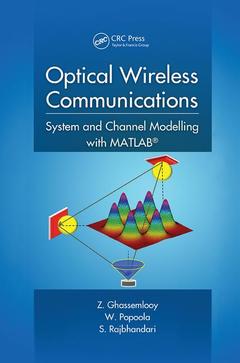Optical Wireless Communications System and Channel Modelling with MATLAB®
Auteurs : Ghassemlooy Z., Popoola W., Rajbhandari S.

Detailing a systems approach, Optical Wireless Communications: System and Channel Modelling with MATLAB®, is a self-contained volume that concisely and comprehensively covers the theory and technology of optical wireless communications systems (OWC) in a way that is suitable for undergraduate and graduate-level students, as well as researchers and professional engineers.
Incorporating MATLAB® throughout, the authors highlight past and current research activities to illustrate optical sources, transmitters, detectors, receivers, and other devices used in optical wireless communications. They also discuss both indoor and outdoor environments, discussing how different factors?including various channel models?affect system performance and mitigation techniques.
In addition, this book broadly covers crucial aspects of OWC systems:
- Fundamental principles of OWC
- Devices and systems
- Modulation techniques and schemes (including polarization shift keying)
- Channel models and system performance analysis
- Emerging visible light communications
- Terrestrial free space optics communication
- Use of infrared in indoor OWC
One entire chapter explores the emerging field of visible light communications, and others describe techniques for using theoretical analysis and simulation to mitigate channel impact on system performance. Additional topics include wavelet denoising, artificial neural networks, and spatial diversity. Content also covers different challenges encountered in OWC, as well as outlining possible solutions and current research trends. A major attraction of the book is the presentation of MATLAB simulations and codes, which enable readers to execute extensive simulations and better understand OWC in general.
Introduction: Optical Wireless Communication Systems. Optical Sources and Detectors. Channel Modelling. Modulation Techniques. System Performance Analysis: Indoor. FSO Link Performance under the Effect of Atmospheric Turbulence. Outdoor OWC Links with Diversity Techniques. Visible Light Communications.
Professor Zabih Ghassemlooy (CEng, Fellow of IET, senior member of IEEE) received his BSc (Hons.) in electrical and electronics engineering from the Manchester Metropolitan University in 1981, and his MSc and Ph.D in optical communications from the University of Manchester Institute of Science and Technology thereafter in 1984 and 1987, respectively. Currently he is an associate dean for research in the School of Computing, Engineering and Information Sciences, University of Northumbria at Newcastle upon Tyne, UK. He also heads the Northumbria Communications Research Laboratories within the school. His research interests are mainly in the area of optical communications, and published over 415 papers. He is the founder and the chairman of the IEEE, IET International Symposium on Communication Systems, Network and Digital Signal Processing.
Dr. W. Popoola had his national diploma in electrical engineering from The Federal Polytechnic, Ilaro, Nigeria and later graduated with first class honours degree in electronic and electrical engineering from Obafemi Awolowo University, Nigeria. He later proceeded to Northumbria University at Newcastle upon Tyne, England, UK, for his MSc in optoelectronic and communication systems where he graduated with distinction in 2006. He was awarded his Ph.D. in 2009 at the Northumbria University for his research work in free-space optical communications. He is currently a researcher with the Institute for Digital Communications, University of Edinburgh, UK working on visible light communications.
Dr. S. Rajbhandari obtained his bachelor degree in electronics and communication engineering from the Institute of Engineering, Pulchowk Campus (Tribhuvan University), Nepal in 2004. In 2006, he received an MSc in optoelectronic and communication systems with distinction and was awarded the P. O. Byrne prize for most innovative project. He then joined the Optical Communications Rese
Date de parution : 04-2017
15.6x23.4 cm
Thème d’Optical Wireless Communications :
Mots-clés :
Atmospheric Channel; MATLAB Code; optical wireless systems; Irradiance Fluctuation; optical wireless design; Atmospheric Turbulence; optical recievers; Normalize SNR; optical transmitters; Optical Wireless Communication Systems; visible light; Outage Probability; ultraviolet; RMS Delay Spread; MATLAB codes; Turbulent Atmospheric Channel; visible bands; Ppm; Optical Wireless; infrared bands; White Lead; free space optics; VLC; BER Expression; BLW; VLC System; Cumulative Distribution Function; BER Performance; Diversity Gain; Wireless LAN; Power Penalty; SDD; Negative Exponential; Subcarrier Signal; Fir Filter



